Bechamel sauce is a basic white sauce. I like to add cheese, pepper, and some herbs to it for lasagne, otherwise it just tastes, well ...
white. And that's not much fun. It's a little fiddly if you're doing it from scratch, but not too difficult. It does require a lot of stirring, and you really can't walk away from it at any point, though. Make sure you have a good twenty minutes up your sleeve before you start.

Here's our cast: butter (I always use unsalted), plain flour, cracked pepper, reduced fat cheese (I'll tell you why in a second), milk (any kind is fine. I'm using reduced fat) and some fresh herbs - parsley and chives.

The amount of sauce you end up with is dependent on the amount of butter you start with. I don't measure anything (you've probably already noticed that), but this is about 100g. I would use more rather than less if you're unsure.
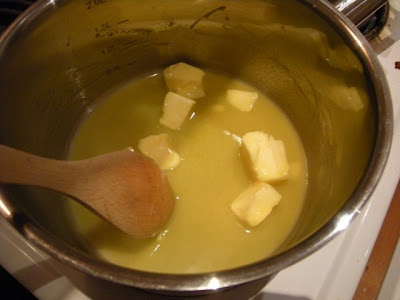
Put the saucepan over a very low heat, and chop the butter up a little to help it melt. Stir it around so that it melts evenly, you don't want it to start bubbling if you can help it.

Once the butter is completely melted, grab a heaped tablespoon full of flour. It pays to have your flour right next to the stove, you can stir with one hand and grab flour with the other. You do need to work reasonably quickly, at least to start with.
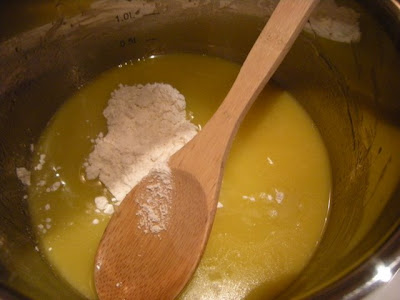
Dump the flour into the butter.
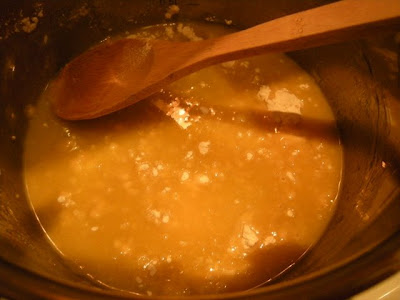
Quickly stir it all up. I tend to use a wooden spoon for this, so that I can get in to the edges of the saucepan, and make sure it all gets incorporated. Don't worry about any lumps at this stage. We can worry about those in good time later on.

Once the flour is all incorporated, the sauce should go smooth, and start to thicken almost immediately.

Get another spoonful of flour ready, and dump it in.

Stir it all in. Keep going on this process until all the melted butter has been completely incorporated, and the mixture is stiff.

Getting thicker. By adding the flour incrementally, we can be sure to get the right proportion (see my earlier comment about not measuring things!). By stirring it smooth after each addition, we also end up with a lovely smooth roux. A smooth roux is the key for a smooth sauce.

Like this! This took about four heaped tablespoons of flour. Now to make it liquid again ...

Slosh in some milk ...

And stir it all around. It will thicken up quite quickly, so move fast.

Add another slosh of milk, stir it in, and keep stirring while it thickens. This will take longer and longer each time you add the milk. Make sure you add small quantities at a time (it's very tempting to add a lot, but it will slow the whole process down significantly, because you need to heat the whole lot again).
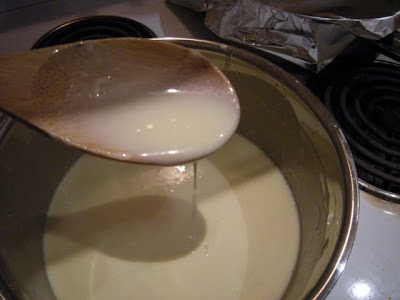
This is still a bit thin, but if you have a heavy-bottomed saucepan, it will continue to thicken as we go through the next few steps. The price you pay for a smooth sauce is eternal vigilance: you'll only get lumps if you let it sit on the heat without stirring it. But, if you
do have lumps at this stage, never fear! Add a little extra milk, and get your balloon whisk out. Give it a really vigorous beat to get the lumps out, and it should come good.

If your sauce is thick enough already, or if you have a heavy-based saucepan, turn the heat off. Then grab your herbs and those trusty scissors, and start snipping.
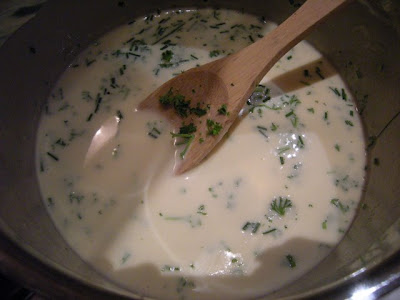
Don't forget to keep stirring it, because it will continue to cook for a little while yet.
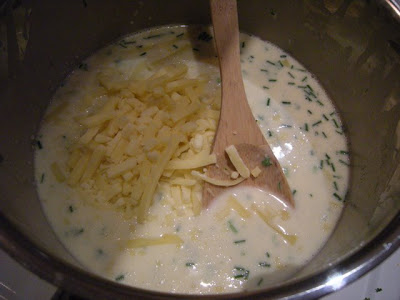
Dump in a good amount of grated cheese. I use low-fat so that the lasagne doesn't end up swimming in grease when it's cooked.

Add in a good dose of pepper, mix it all around, and then let it sit uncovered while you get started on Phase 3: Garlic Bread.
 Here's our cast: butter (I always use unsalted), plain flour, cracked pepper, reduced fat cheese (I'll tell you why in a second), milk (any kind is fine. I'm using reduced fat) and some fresh herbs - parsley and chives.
Here's our cast: butter (I always use unsalted), plain flour, cracked pepper, reduced fat cheese (I'll tell you why in a second), milk (any kind is fine. I'm using reduced fat) and some fresh herbs - parsley and chives. The amount of sauce you end up with is dependent on the amount of butter you start with. I don't measure anything (you've probably already noticed that), but this is about 100g. I would use more rather than less if you're unsure.
The amount of sauce you end up with is dependent on the amount of butter you start with. I don't measure anything (you've probably already noticed that), but this is about 100g. I would use more rather than less if you're unsure. Put the saucepan over a very low heat, and chop the butter up a little to help it melt. Stir it around so that it melts evenly, you don't want it to start bubbling if you can help it.
Put the saucepan over a very low heat, and chop the butter up a little to help it melt. Stir it around so that it melts evenly, you don't want it to start bubbling if you can help it. Once the butter is completely melted, grab a heaped tablespoon full of flour. It pays to have your flour right next to the stove, you can stir with one hand and grab flour with the other. You do need to work reasonably quickly, at least to start with.
Once the butter is completely melted, grab a heaped tablespoon full of flour. It pays to have your flour right next to the stove, you can stir with one hand and grab flour with the other. You do need to work reasonably quickly, at least to start with. Dump the flour into the butter.
Dump the flour into the butter. Quickly stir it all up. I tend to use a wooden spoon for this, so that I can get in to the edges of the saucepan, and make sure it all gets incorporated. Don't worry about any lumps at this stage. We can worry about those in good time later on.
Quickly stir it all up. I tend to use a wooden spoon for this, so that I can get in to the edges of the saucepan, and make sure it all gets incorporated. Don't worry about any lumps at this stage. We can worry about those in good time later on. Once the flour is all incorporated, the sauce should go smooth, and start to thicken almost immediately.
Once the flour is all incorporated, the sauce should go smooth, and start to thicken almost immediately. Get another spoonful of flour ready, and dump it in.
Get another spoonful of flour ready, and dump it in. Stir it all in. Keep going on this process until all the melted butter has been completely incorporated, and the mixture is stiff.
Stir it all in. Keep going on this process until all the melted butter has been completely incorporated, and the mixture is stiff. Getting thicker. By adding the flour incrementally, we can be sure to get the right proportion (see my earlier comment about not measuring things!). By stirring it smooth after each addition, we also end up with a lovely smooth roux. A smooth roux is the key for a smooth sauce.
Getting thicker. By adding the flour incrementally, we can be sure to get the right proportion (see my earlier comment about not measuring things!). By stirring it smooth after each addition, we also end up with a lovely smooth roux. A smooth roux is the key for a smooth sauce. Like this! This took about four heaped tablespoons of flour. Now to make it liquid again ...
Like this! This took about four heaped tablespoons of flour. Now to make it liquid again ... Slosh in some milk ...
Slosh in some milk ... And stir it all around. It will thicken up quite quickly, so move fast.
And stir it all around. It will thicken up quite quickly, so move fast. Add another slosh of milk, stir it in, and keep stirring while it thickens. This will take longer and longer each time you add the milk. Make sure you add small quantities at a time (it's very tempting to add a lot, but it will slow the whole process down significantly, because you need to heat the whole lot again).
Add another slosh of milk, stir it in, and keep stirring while it thickens. This will take longer and longer each time you add the milk. Make sure you add small quantities at a time (it's very tempting to add a lot, but it will slow the whole process down significantly, because you need to heat the whole lot again). This is still a bit thin, but if you have a heavy-bottomed saucepan, it will continue to thicken as we go through the next few steps. The price you pay for a smooth sauce is eternal vigilance: you'll only get lumps if you let it sit on the heat without stirring it. But, if you do have lumps at this stage, never fear! Add a little extra milk, and get your balloon whisk out. Give it a really vigorous beat to get the lumps out, and it should come good.
This is still a bit thin, but if you have a heavy-bottomed saucepan, it will continue to thicken as we go through the next few steps. The price you pay for a smooth sauce is eternal vigilance: you'll only get lumps if you let it sit on the heat without stirring it. But, if you do have lumps at this stage, never fear! Add a little extra milk, and get your balloon whisk out. Give it a really vigorous beat to get the lumps out, and it should come good. If your sauce is thick enough already, or if you have a heavy-based saucepan, turn the heat off. Then grab your herbs and those trusty scissors, and start snipping.
If your sauce is thick enough already, or if you have a heavy-based saucepan, turn the heat off. Then grab your herbs and those trusty scissors, and start snipping. Don't forget to keep stirring it, because it will continue to cook for a little while yet.
Don't forget to keep stirring it, because it will continue to cook for a little while yet. Dump in a good amount of grated cheese. I use low-fat so that the lasagne doesn't end up swimming in grease when it's cooked.
Dump in a good amount of grated cheese. I use low-fat so that the lasagne doesn't end up swimming in grease when it's cooked. Add in a good dose of pepper, mix it all around, and then let it sit uncovered while you get started on Phase 3: Garlic Bread.
Add in a good dose of pepper, mix it all around, and then let it sit uncovered while you get started on Phase 3: Garlic Bread.
0 comments:
Post a Comment